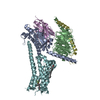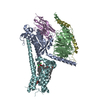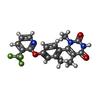[English] 日本語
 Yorodumi
Yorodumi- EMDB-32965: Cryo-EM structure of the tavapadon-bound D1 dopamine receptor and... -
+ Open data
Open data
- Basic information
Basic information
| Entry |  | |||||||||
|---|---|---|---|---|---|---|---|---|---|---|
| Title | Cryo-EM structure of the tavapadon-bound D1 dopamine receptor and mini-Gs complex | |||||||||
 Map data Map data | ||||||||||
 Sample Sample |
| |||||||||
| Function / homology |  Function and homology information Function and homology informationdopamine neurotransmitter receptor activity / cerebral cortex GABAergic interneuron migration /  Dopamine receptors / dopamine neurotransmitter receptor activity, coupled via Gs / Dopamine receptors / dopamine neurotransmitter receptor activity, coupled via Gs /  operant conditioning / operant conditioning /  dopamine binding / regulation of dopamine uptake involved in synaptic transmission / modification of postsynaptic structure / dopamine binding / regulation of dopamine uptake involved in synaptic transmission / modification of postsynaptic structure /  heterotrimeric G-protein binding / heterotrimeric G-protein binding /  sensitization ...dopamine neurotransmitter receptor activity / cerebral cortex GABAergic interneuron migration / sensitization ...dopamine neurotransmitter receptor activity / cerebral cortex GABAergic interneuron migration /  Dopamine receptors / dopamine neurotransmitter receptor activity, coupled via Gs / Dopamine receptors / dopamine neurotransmitter receptor activity, coupled via Gs /  operant conditioning / operant conditioning /  dopamine binding / regulation of dopamine uptake involved in synaptic transmission / modification of postsynaptic structure / dopamine binding / regulation of dopamine uptake involved in synaptic transmission / modification of postsynaptic structure /  heterotrimeric G-protein binding / heterotrimeric G-protein binding /  sensitization / regulation of dopamine metabolic process / dopamine transport / sensitization / regulation of dopamine metabolic process / dopamine transport /  peristalsis / phospholipase C-activating dopamine receptor signaling pathway / G protein-coupled receptor complex / grooming behavior / positive regulation of neuron migration / peristalsis / phospholipase C-activating dopamine receptor signaling pathway / G protein-coupled receptor complex / grooming behavior / positive regulation of neuron migration /  habituation / astrocyte development / habituation / astrocyte development /  conditioned taste aversion / positive regulation of potassium ion transport / striatum development / dentate gyrus development / conditioned taste aversion / positive regulation of potassium ion transport / striatum development / dentate gyrus development /  maternal behavior / arrestin family protein binding / non-motile cilium / adult walking behavior / mating behavior / long-term synaptic depression / ciliary membrane / dopamine receptor signaling pathway / maternal behavior / arrestin family protein binding / non-motile cilium / adult walking behavior / mating behavior / long-term synaptic depression / ciliary membrane / dopamine receptor signaling pathway /  temperature homeostasis / dopamine metabolic process / transmission of nerve impulse / glucose import / behavioral response to cocaine / G protein-coupled receptor signaling pathway, coupled to cyclic nucleotide second messenger / G-protein alpha-subunit binding / neuronal action potential / GABA-ergic synapse / behavioral fear response / temperature homeostasis / dopamine metabolic process / transmission of nerve impulse / glucose import / behavioral response to cocaine / G protein-coupled receptor signaling pathway, coupled to cyclic nucleotide second messenger / G-protein alpha-subunit binding / neuronal action potential / GABA-ergic synapse / behavioral fear response /  prepulse inhibition / adenylate cyclase-activating adrenergic receptor signaling pathway / prepulse inhibition / adenylate cyclase-activating adrenergic receptor signaling pathway /  synapse assembly / activation of adenylate cyclase activity / response to amphetamine / presynaptic modulation of chemical synaptic transmission / positive regulation of synaptic transmission, glutamatergic / positive regulation of release of sequestered calcium ion into cytosol / synapse assembly / activation of adenylate cyclase activity / response to amphetamine / presynaptic modulation of chemical synaptic transmission / positive regulation of synaptic transmission, glutamatergic / positive regulation of release of sequestered calcium ion into cytosol /  synaptic transmission, glutamatergic / G protein-coupled receptor activity / long-term synaptic potentiation / synaptic transmission, glutamatergic / G protein-coupled receptor activity / long-term synaptic potentiation /  regulation of protein phosphorylation / Olfactory Signaling Pathway / Activation of the phototransduction cascade / regulation of protein phosphorylation / Olfactory Signaling Pathway / Activation of the phototransduction cascade /  visual learning / G beta:gamma signalling through PLC beta / Presynaptic function of Kainate receptors / Thromboxane signalling through TP receptor / G-protein activation / G protein-coupled acetylcholine receptor signaling pathway / Activation of G protein gated Potassium channels / Inhibition of voltage gated Ca2+ channels via Gbeta/gamma subunits / Prostacyclin signalling through prostacyclin receptor / Glucagon signaling in metabolic regulation / G beta:gamma signalling through CDC42 / adenylate cyclase-activating G protein-coupled receptor signaling pathway / visual learning / G beta:gamma signalling through PLC beta / Presynaptic function of Kainate receptors / Thromboxane signalling through TP receptor / G-protein activation / G protein-coupled acetylcholine receptor signaling pathway / Activation of G protein gated Potassium channels / Inhibition of voltage gated Ca2+ channels via Gbeta/gamma subunits / Prostacyclin signalling through prostacyclin receptor / Glucagon signaling in metabolic regulation / G beta:gamma signalling through CDC42 / adenylate cyclase-activating G protein-coupled receptor signaling pathway /  cilium / ADP signalling through P2Y purinoceptor 12 / G beta:gamma signalling through BTK / Synthesis, secretion, and inactivation of Glucagon-like Peptide-1 (GLP-1) / cilium / ADP signalling through P2Y purinoceptor 12 / G beta:gamma signalling through BTK / Synthesis, secretion, and inactivation of Glucagon-like Peptide-1 (GLP-1) /  memory / Sensory perception of sweet, bitter, and umami (glutamate) taste / photoreceptor disc membrane / Adrenaline,noradrenaline inhibits insulin secretion / Glucagon-type ligand receptors / Vasopressin regulates renal water homeostasis via Aquaporins / G alpha (z) signalling events / cellular response to catecholamine stimulus / Glucagon-like Peptide-1 (GLP1) regulates insulin secretion / ADORA2B mediated anti-inflammatory cytokines production / sensory perception of taste / ADP signalling through P2Y purinoceptor 1 / adenylate cyclase-activating dopamine receptor signaling pathway / G beta:gamma signalling through PI3Kgamma / cellular response to prostaglandin E stimulus / Cooperation of PDCL (PhLP1) and TRiC/CCT in G-protein beta folding / memory / Sensory perception of sweet, bitter, and umami (glutamate) taste / photoreceptor disc membrane / Adrenaline,noradrenaline inhibits insulin secretion / Glucagon-type ligand receptors / Vasopressin regulates renal water homeostasis via Aquaporins / G alpha (z) signalling events / cellular response to catecholamine stimulus / Glucagon-like Peptide-1 (GLP1) regulates insulin secretion / ADORA2B mediated anti-inflammatory cytokines production / sensory perception of taste / ADP signalling through P2Y purinoceptor 1 / adenylate cyclase-activating dopamine receptor signaling pathway / G beta:gamma signalling through PI3Kgamma / cellular response to prostaglandin E stimulus / Cooperation of PDCL (PhLP1) and TRiC/CCT in G-protein beta folding /  vasodilation / protein import into nucleus / GPER1 signaling / G-protein beta-subunit binding / Inactivation, recovery and regulation of the phototransduction cascade / vasodilation / protein import into nucleus / GPER1 signaling / G-protein beta-subunit binding / Inactivation, recovery and regulation of the phototransduction cascade /  heterotrimeric G-protein complex / G alpha (12/13) signalling events / heterotrimeric G-protein complex / G alpha (12/13) signalling events /  extracellular vesicle / signaling receptor complex adaptor activity / Thrombin signalling through proteinase activated receptors (PARs) / retina development in camera-type eye / extracellular vesicle / signaling receptor complex adaptor activity / Thrombin signalling through proteinase activated receptors (PARs) / retina development in camera-type eye /  GTPase binding / GTPase binding /  presynaptic membrane presynaptic membraneSimilarity search - Function | |||||||||
| Biological species |   Homo sapiens (human) / synthetic construct (others) Homo sapiens (human) / synthetic construct (others) | |||||||||
| Method |  single particle reconstruction / single particle reconstruction /  cryo EM / Resolution: 3.3 Å cryo EM / Resolution: 3.3 Å | |||||||||
 Authors Authors | Teng X / Zheng S | |||||||||
| Funding support |  China, 1 items China, 1 items
| |||||||||
 Citation Citation |  Journal: Nat Commun / Year: 2022 Journal: Nat Commun / Year: 2022Title: Ligand recognition and biased agonism of the D1 dopamine receptor. Authors: Xiao Teng / Sijia Chen / Yingying Nie / Peng Xiao / Xiao Yu / Zhenhua Shao / Sanduo Zheng /  Abstract: Dopamine receptors are widely distributed in the central nervous system and are important therapeutic targets for treatment of various psychiatric and neurological diseases. Here, we report three ...Dopamine receptors are widely distributed in the central nervous system and are important therapeutic targets for treatment of various psychiatric and neurological diseases. Here, we report three cryo-electron microscopy structures of the D1 dopamine receptor (D1R)-Gs complex bound to two agonists, fenoldopam and tavapadon, and a positive allosteric modulator LY3154207. The structure reveals unusual binding of two fenoldopam molecules, one to the orthosteric binding pocket (OBP) and the other to the extended binding pocket (EBP). In contrast, one elongated tavapadon molecule binds to D1R, extending from OBP to EBP. Moreover, LY3154207 stabilizes the second intracellular loop of D1R in an alpha helical conformation to efficiently engage the G protein. Through a combination of biochemical, biophysical and cellular assays, we further show that the broad conformation stabilized by two fenoldopam molecules and interaction between TM5 and the agonist are important for biased signaling of D1R. | |||||||||
| History |
|
- Structure visualization
Structure visualization
| Supplemental images |
|---|
- Downloads & links
Downloads & links
-EMDB archive
| Map data |  emd_32965.map.gz emd_32965.map.gz | 20.9 MB |  EMDB map data format EMDB map data format | |
|---|---|---|---|---|
| Header (meta data) |  emd-32965-v30.xml emd-32965-v30.xml emd-32965.xml emd-32965.xml | 17.6 KB 17.6 KB | Display Display |  EMDB header EMDB header |
| Images |  emd_32965.png emd_32965.png | 32.1 KB | ||
| Archive directory |  http://ftp.pdbj.org/pub/emdb/structures/EMD-32965 http://ftp.pdbj.org/pub/emdb/structures/EMD-32965 ftp://ftp.pdbj.org/pub/emdb/structures/EMD-32965 ftp://ftp.pdbj.org/pub/emdb/structures/EMD-32965 | HTTPS FTP |
-Related structure data
| Related structure data |  7x2dMC  7x2cC  7x2fC M: atomic model generated by this map C: citing same article ( |
|---|---|
| Similar structure data | Similarity search - Function & homology  F&H Search F&H Search |
- Links
Links
| EMDB pages |  EMDB (EBI/PDBe) / EMDB (EBI/PDBe) /  EMDataResource EMDataResource |
|---|---|
| Related items in Molecule of the Month |
- Map
Map
| File |  Download / File: emd_32965.map.gz / Format: CCP4 / Size: 22.2 MB / Type: IMAGE STORED AS FLOATING POINT NUMBER (4 BYTES) Download / File: emd_32965.map.gz / Format: CCP4 / Size: 22.2 MB / Type: IMAGE STORED AS FLOATING POINT NUMBER (4 BYTES) | ||||||||||||||||||||
|---|---|---|---|---|---|---|---|---|---|---|---|---|---|---|---|---|---|---|---|---|---|
| Voxel size | X=Y=Z: 1.087 Å | ||||||||||||||||||||
| Density |
| ||||||||||||||||||||
| Symmetry | Space group: 1 | ||||||||||||||||||||
| Details | EMDB XML:
|
-Supplemental data
- Sample components
Sample components
+Entire : Cryo-EM structure of the tavapadon-bound D1R-miniGs complex
+Supramolecule #1: Cryo-EM structure of the tavapadon-bound D1R-miniGs complex
+Supramolecule #2: tavapadon-bound D1R-miniGs
+Supramolecule #3: nanobody35
+Macromolecule #1: D(1A) dopamine receptor
+Macromolecule #2: Guanine nucleotide-binding protein G(s) subunit alpha isoforms short
+Macromolecule #3: Guanine nucleotide-binding protein G(I)/G(S)/G(T) subunit beta-1
+Macromolecule #4: Guanine nucleotide-binding protein G(I)/G(S)/G(O) subunit gamma-2
+Macromolecule #5: Nanobody35
+Macromolecule #6: CHOLESTEROL
+Macromolecule #7: 1,5-dimethyl-6-[2-methyl-4-[3-(trifluoromethyl)pyridin-2-yl]oxy-p...
-Experimental details
-Structure determination
| Method |  cryo EM cryo EM |
|---|---|
 Processing Processing |  single particle reconstruction single particle reconstruction |
| Aggregation state | particle |
- Sample preparation
Sample preparation
| Concentration | 4.0 mg/mL |
|---|---|
| Buffer | pH: 7.5 |
| Grid | Model: Quantifoil R1.2/1.3 / Material: GOLD / Mesh: 300 / Support film - Material: CARBON / Support film - topology: HOLEY / Pretreatment - Type: GLOW DISCHARGE |
| Vitrification | Cryogen name: ETHANE / Chamber humidity: 100 % / Chamber temperature: 281 K / Instrument: FEI VITROBOT MARK IV |
- Electron microscopy
Electron microscopy
| Microscope | FEI TITAN KRIOS |
|---|---|
| Electron beam | Acceleration voltage: 300 kV / Electron source:  FIELD EMISSION GUN FIELD EMISSION GUN |
| Electron optics | Illumination mode: FLOOD BEAM / Imaging mode: BRIGHT FIELD Bright-field microscopy / Nominal defocus max: 2.0 µm / Nominal defocus min: 0.7000000000000001 µm / Nominal magnification: 64000 Bright-field microscopy / Nominal defocus max: 2.0 µm / Nominal defocus min: 0.7000000000000001 µm / Nominal magnification: 64000 |
| Sample stage | Cooling holder cryogen: NITROGEN |
| Image recording | Film or detector model: GATAN K3 BIOQUANTUM (6k x 4k) / Number real images: 1861 / Average electron dose: 50.0 e/Å2 |
| Experimental equipment |  Model: Titan Krios / Image courtesy: FEI Company |
- Image processing
Image processing
| Particle selection | Number selected: 1964454 |
|---|---|
| CTF correction | Software - Name: cryoSPARC (ver. v3) Software - details: CTF parameters were estimated using patch-based CTF estimation |
| Startup model | Type of model: EMDB MAP EMDB ID: |
| Initial angle assignment | Type: MAXIMUM LIKELIHOOD |
| Final 3D classification | Number classes: 3 |
| Final angle assignment | Type: MAXIMUM LIKELIHOOD |
| Final reconstruction | Number classes used: 1 / Resolution.type: BY AUTHOR / Resolution: 3.3 Å / Resolution method: FSC 0.143 CUT-OFF / Number images used: 399390 |
 Movie
Movie Controller
Controller






























